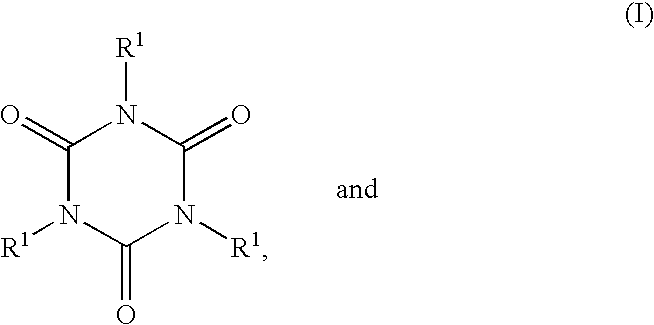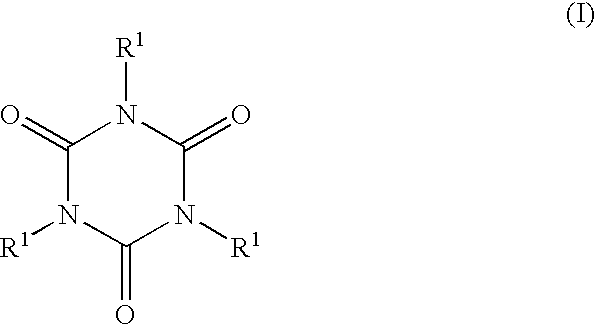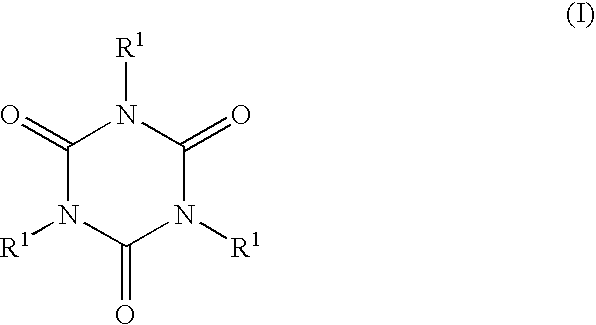Curing agents curable compositions, compositions for optical materials, optical materials their production and liquid crystal displays and led's made by using the material
a technology of curable compositions and curable agents, applied in the direction of organic chemistry, chemistry apparatus and processes, transportation and packaging, etc., can solve the problems of increasing birefringence and photoelasticity, self-limiting of the scope of its utility, and difficult to reconcile high heat resistance with good optical properties
- Summary
- Abstract
- Description
- Claims
- Application Information
AI Technical Summary
Benefits of technology
Problems solved by technology
Method used
Image
Examples
example of synthesis-2
HBPA-AE
[0325] A four-necked flask of 500 mL capacity was fitted with a stirring apparatus and a condenser. This flask was charged with 6.49 g of 2,2-bis(4-hydroxycyclohexyl)propane (product of Tokyo kasei Kogyo Co., Ltd.), 243 g of 50 wt % aqueous solution of sodium hydroxide, 3.54 g of tetra-n-butylammonium bromide, 20.5 g of allyl chloride, and 16.0 mL of xylene, and the mixture was heated and stirred under nitrogen at 60.degree. C. for 5 hours and then at 70.degree. C. for 4 hours. Using a separatory funnel, the organic layer was separated, washed once with 50 mL of 1N-HCl and 4 times with 200 mL of water, and dehydrated over magnesium sulfate. The solvent was then removed under reduced pressure in an evaporator at 60 to 70.degree. C. to recover a light-yellow liquid. .sup.1H-NMR analysis revealed that it was the 2,2-bis(4-hydroxycyclohexyl-) propane diallyl ether produced by allyl etherification of the OH groups of hydrogenated bisphenol A.
example 1
TVCH
[0326] A four-necked flask of 1 L capacity was fitted with a stirring apparatus, a condenser, and a dropping funnel. This flask was charged with 190 g of toluene, 48 mg of platinum vinylsiloxane complex-in-xylene (platinum content 3 wt %), and 236.2 g of 1,3,5,7-tetramethylcyclotetrasi-loxane and the mixture was heated and stirred on an oil bath at 70.degree. C. To this solution was added a solution of 20.0 g of 1,2,4-trivinylcyclohexane (number of vinyl groups: 3, molecular weight: 162, viscosity: less than 1 poise) in 10 g of toluene dropwise over 1 hour. The resulting solution was heated and stirred on an oil bath at 70.degree. C. for 90 minutes. Then, 9.2 mg of 1-ethynyl-1-cyclohexanol was added. The unreacted 1,3,5,7-tetramethylcyclotetrasiloxane and the toluene were then removed under reduced pressure. .sup.1H-NMR analysis revealed that this was the reaction product of part of the SiH groups of 1,3,5,7-tetramethylcyclotetrasiloxane with 1,2,4-trivinylcyclohexane (This prod...
example 2
HBPAH
[0327] A two-necked flask of 200 mL capacity was fitted with a stirring apparatus, a condenser, and a dropping funnel. This flask was charged with 40.0 g of toluene and 36.0 g of 1,3,5,7-tetramethylcyclotetrasiloxan-e and the mixture was heated and stirred on an oil bath at 80.degree. C. To this solution was added a mixture of 9.6 g of 2,2-bis(4-hydroxycyclohe-xyl)propane diallyl ether synthesized in Example of Synthesis-2 (number of vinyl groups: 2, molecular weight: 320, viscosity: less than 1 poise), 10.0 g of toluene, and 4.5 .mu.l of platinum vinylsiloxane complex-in-xylene (platinum content: 3 wt. %) dropwise over 15 minutes. The resulting solution was heated and stirred on an oil bath at 80.degree. C. for 30 minutes. Then, 7.5 mg of 1-ethynyl-1-cyclohexanol was added and the unreacted 1,3,5,7-tetramethylcyclotetrasiloxane and the toluene were removed under reduced pressure to recover 20.5 g of product. .sup.1H-NMR analysis revealed that this was the reaction product of p...
PUM
| Property | Measurement | Unit |
|---|---|---|
| viscosity | aaaaa | aaaaa |
| viscosity | aaaaa | aaaaa |
| viscosity | aaaaa | aaaaa |
Abstract
Description
Claims
Application Information
 Login to View More
Login to View More - R&D
- Intellectual Property
- Life Sciences
- Materials
- Tech Scout
- Unparalleled Data Quality
- Higher Quality Content
- 60% Fewer Hallucinations
Browse by: Latest US Patents, China's latest patents, Technical Efficacy Thesaurus, Application Domain, Technology Topic, Popular Technical Reports.
© 2025 PatSnap. All rights reserved.Legal|Privacy policy|Modern Slavery Act Transparency Statement|Sitemap|About US| Contact US: help@patsnap.com



